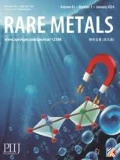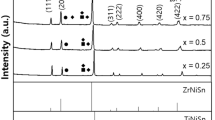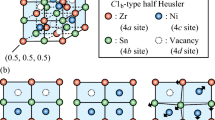Abstract
The thermoelectric transport properties of Zr0.43Hf0.57NiSn half-Heusler compounds were investigated for samples sintered with different spark plasma sintering (SPS) periods: 8, 32 and 72 min. By means of scanning transmission electron microscopy with a high-angular annular dark-field detector (STEM-HAADF), it was found that sintering time affected the defect concentration, namely the amount of Ni interstitial atoms, and created locally ordered inclusions of full-Heusler phase. The structural information, phase composition and electrical transport properties could be consistently explained by the assumption that Ni interstitials give rise to an impurity band situated about 100 meV below the bottom of the conduction band via a self-doping behavior. The impurity band was found to merge with the conduction band for the sample with intermediate SPS time. The effect was ascribed to the gradual dissolution of full-Heusler phase inclusions and production of interstitial Ni defects, which eventually vanished for the sample with the longest sintering time. It was demonstrated that the modification of the density of states near the edge of the conduction band and enhanced overall charge carrier concentration provided by defect engineering led to overall 26% increase in the thermoelectric figure of merit (ZT) with respect to the other samples.
Graphic abstract









Similar content being viewed by others
References
Xie W, Weidenkaff A, Tang X, Zhang Q, Poon J, Tritt TM. Recent advances in nanostructured thermoelectric half-Heusler compounds. Nanomaterials. 2012;2(4):379.
Uher C, Yang J, Hu S, Morelli D, Meisner G. Transport properties of pure and doped MNiSn (M = Zr, Hf). Phys Rev B. 1999;59(13):8615.
Shen Q, Chen L, Goto T, Hirai T, Yang J, Meisner G, Uher C. Effects of partial substitution of Ni by Pd on the thermoelectric properties of ZrNiSn-based half-Heusler compounds. Appl Phys Lett. 2001;79(25):4165.
Gałązka K, Populoh S, Xie W, Yoon S, Saucke G, Hulliger J, Weidenkaff A. Improved thermoelectric performance of (Zr0.3Hf0.7)NiSn half-Heusler compounds by Ta substitution. J Appl Phys. 2014;115(18):183704.
Ogut S, Rabe K. Band gap and stability in the ternary intermetallic compounds NiSnM (M = Ti, Zr, Hf): a first-principles study. Phys Rev B. 1995;51(16):10443.
Colinet C, Jund P, Tedenac J. NiTiSn a material of technological interest: ab initio calculations of phase stability and defects. Intermetallics. 2014;46:103.
Miyazaki H, Nakano T, Inukai M, Soda K, Izumi Y, Muro T, Kim J, Takata M, Matsunami M, Kimura S, Nishino Y. Electronic and local crystal structures of the ZrNiSn Half-Heusler thermoelectric material. Mater Trans. 2014;55(8):1209.
Do D, Mahanti S, Pulikkotil J. Electronic structure of Zr–Ni–Sn systems: role of clustering and nanostructures in half-Heusler and Heusler limits. J Phys Condens Mater. 2014;26(27):275501.
Chai Y, Kimura Y. Nanosized precipitates in half-Heusler TiNiSn alloy. Appl Phys Lett. 2012;100(3):033114.
Chai Y, Kimura Y. Microstructure evolution of nanoprecipitates in half-Heusler TiNiSn alloys. Acta Mater. 2013;61(18):6684.
Chai Y, Yoshioka K, Kimura Y. Intrinsic point defects in thermoelectric half-Heusler alloys. Scr Mater. 2014;83:13.
Sahoo P, Liu Y, Makongo J, Su X, Kim S, Takas N, Chi H, Uher C, Pan X, Poudeu P. Enhancing thermopower and hole mobility in bulk p-type half-Heuslers using full-Heusler nanostructures. Nanoscale. 2013;5(19):9419.
Xie H, Mi J, Hu L, Lock N, Chirstensen M, Fu C, Iversen B, Zhao X, Zhu T. Interrelation between atomic switching disorder and thermoelectric properties of ZrNiSn half-Heusler compounds. CrystEngComm. 2012;14(13):4467.
Morimura T, Hasaka M. ALCHEMI for coexistent Heusler and half-Heusler phases in TiNi1.5Sn. Ultramicroscopy. 2006;106(7):553.
Xie H, Wang H, Fu C, Liu Y, Snyder G, Zhao X, Zhu T. The intrinsic disorder related alloy scattering in ZrNiSn half-Heusler thermoelectric materials. Sci Rep. 2014;4:6888.
Zhou M, Chen L, Feng C, Wang D, Li J. Moderate-temperature thermoelectric properties of TiCoSb-based half-Heusler compounds Ti1−xTaxCoSb. J Appl Phys. 2007;101(11):113714.
Le Bail A, Duroy H, Fourquet J. Ab-initio structure determination of LiSbWO6 by X-ray powder diffraction. Mater Res Bull. 1988;23(3):447.
Rodríguez-Carvajal J. Recent advances in magnetic structure determination by neutron powder diffraction. Phys B. 1993;192(1–2):55.
Stokes A, Wilson A. The diffraction of X rays by distorted crystal aggregates—I. Proc Phys Soc Lond. 1944;56(3):174.
Thompson P, Cox D, Hastings J. Rietveld refinement of Debye–Scherrer synchrotron X-ray data from Al2O3. J Appl Crystallogr. 1987;20(2):79.
Schwall M, Balke B. Niobium substitution in Zr0.5Hf0.5NiSn based Heusler compounds for high power factors. Appl Phys Lett. 2011;98(4):042106.
Shutoh N, Sakurada S. Thermoelectric properties of the Tix(Zr0.5Hf0.5)1−xNiSn half-Heusler compounds. J Alloy Compd. 2005;389(1):204.
Hohl H, Ramirez A, Kaefer W, Fess K, Thurner C, Kloc C, Bucher E. A new class of materials with promising thermoelectric properties: MNiSn (M = Ti, Zr, Hf). MRS Proc. 1997;478:109.
Jeitschko W. Transition metal stannides with MgAgAs and MnCu2Al type structure. Met Trans. 1970;1(11):3159.
Yu C, Xie H, Fu C, Zhu T, Zhao X. High performance half-Heusler thermoelectric materials with refined grains and nanoscale precipitates. J Mater Res. 2012;27(19):2457.
Fritzsche H. Resistivity and hall coefficient of antimony-doped germanium at low temperatures. J Phys Chem Solids. 1958;6(1):69.
Bergman DJ. Electrical transport properties near a classical conductivity or percolation threshold. Phys A. 1989;157(1):72.
Dai U, Palevski A, Deutscher G. Hall effect in a three-dimensional percolation system. Phys Rev B. 1987;36(1):790.
Cook B, Meisner G, Yang J, Uher C. High temperature thermoelectric properties of MNiSn (M = Zr, Hf). In: Proceedings of eighteenth international conference on thermoelectrics, Baltimore, IEEE; 1999, 64.
Schmitt J, Gibbs Z, Snyder G, Felser C. Resolving the true band gap of ZrNiSn half-Heusler thermoelectric materials. Mater Horiz. 2015;2(1):68.
Zou D, Xie S, Liu Y, Lin J, Li J. Electronic structure and thermoelectric properties of half-Heusler Zr0.5Hf0.5NiSn by first-principles calculations. J Appl Phys. 2013;113(19):193705.
Graf T, Felser C, Parkin S. Simple rules for the understanding of Heusler compounds. Prog Solid State Chem. 2011;39(1):1.
Qiu P, Yang J, Huang X, Chen X, Chen L. Effect of antisite defects on band structure and thermoelectric performance of ZrNiSn half-Heusler alloys. Appl Phys Lett. 2010;96(15):152105.
Blakemore J. Semiconductor statistics. New York: Dover Publications, Inc.; 1987. 1.
Hazama H, Asahi R, Matsubara M, Takeuchi T. Study of electronic structure and defect formation in Ti1−xNi1+xSn Half-Heusler alloys. J Electro Mater. 2010;39(9):1549.
Aliev F, Brandt N, Moshchalkov V, Kozyrkov V, Skolozdra R, Belogorokhov A. Gap at the Fermi level in the intermetallic vacancy system RBiSn(R = Ti, Zr, Hf). Z Phys B Condens Matter. 1989;75(2):167.
Arushanov E, Kaefer W, Fess K, Kloc C, Friemelt K, Bucher E. Transport properties of n-ZrNiSn single crystals. Phys Status Solidi A. 2000;177(2):511.
Conwell E. Impurity band conduction in germanium and silicon. Phys Rev. 1956;103(1):51.
Hung C. Theory of resistivity and hall effect at very low temperatures. Phys Rev. 1950;79(4):727.
Putley EH. The Hall effect and related phenomena. London: Butterworth & Co.; 1960. 1.
Simonson J, Wu D, Xie W, Tritt T, Poon S. Introduction of resonant states and enhancement of thermoelectric properties in half-Heusler alloys. Phys Rev B. 2011;83(23):235211.
Xie H, Wang H, Pei Y, Fu C, Liu X, Snyder G, Zhao X, Zhu T. Beneficial contribution of alloy disorder to electron and phonon transport in half-heusler thermoelectric materials. Adv Funct Mater. 2013;23(41):5123.
Mott N, Twose W. The theory of impurity conduction. Adv Phys. 1961;10(38):107.
Matthiessen A, Vogt C. On the influence of temperature on the electric conducting-power of alloy. Philos Trans R Soc. 1864;154:167.
Nolas G, Sharp J, Goldsmid H. Thermoelectrics: basic principles and new materials developments. Berlin: Springer; 2001. 1.
Conwell E, Weisskopf V. Theory of impurity scattering in semiconductors. Phys Rev. 1950;77(3):388.
Fritzsche H, Lark-Horovitz K. Electrical properties of p-type indium antimonide at low temperatures. Phys Rev. 1955;99(2):400.
Ioffe A. Fizika Poluprovodnikov. Moscow: Publishing House of USSR; 1957. 1.
Goldsmid H, Sharp J. Estimation of the thermal band gap of a semiconductor from seebeck measurements. J Electro Mater. 1999;28(7):869.
Tritt T. Thermal conductivity: theory, properties, and applications. New York: Kluwer Academic/Plenum Publishers; 2004. 1.
Acknowledgments
This work was financially supported by German Research Foundation Priority Programme 1386 (No.WE 2803/2-2) and the European Union under Marie Skłodowska-Curie Program (W. J. X.). We also gratefully acknowledge the Laboratorio de Microscopias Avanzadas at Instituto de Nanociencia de Aragon, Universidad de Zaragoza, where the aberration-corrected TEM studies were conducted, and thank Prof. Jürg Hulliger for their critical discussion and comments.
Author information
Authors and Affiliations
Corresponding authors
Electronic supplementary material
Below is the link to the electronic supplementary material.
Rights and permissions
About this article
Cite this article
Gałązka, K., Xie, W., Populoh, S. et al. Tailoring thermoelectric properties of Zr0.43Hf0.57NiSn half-Heusler compound by defect engineering. Rare Met. 39, 659–670 (2020). https://doi.org/10.1007/s12598-020-01392-7
Received:
Revised:
Accepted:
Published:
Issue Date:
DOI: https://doi.org/10.1007/s12598-020-01392-7




